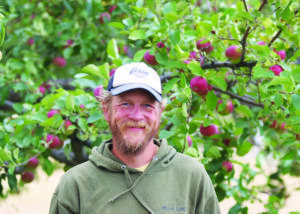
by John Dowd
Since its statehood, in 1889, the backbone of Montana’s economy has been agriculture. Being its number one industry, many are working to maintain the survival of Montana’s agriculture in an ever-changing world. One group has been doing this for over 116 years, and according to them, they need the community’s help.
The Western Agricultural Research Center (WARC) northeast of Corvallis was established in 1907 by Montana State University and is the only one of their seven agricultural research centers that prioritized fruits and vegetables. “We really serve the whole state and even into surrounding states,” said Zach Miller, a professor and superintendent of WARC. Miller said that the WARC space is just over 30 acres in size, yet the variety of studies they do every year is impressive. “There is a huge need and demand for this type of research.” WARC was set up as a state horticultural farm to support the apple growers during the valley apple boom in the early 1900s. Soon, the facility grew to do much more research in a huge variety of ways for horticulture.

One hundred years ago, the Bitterroot Valley had significant apple producers, and apple orchards covered an estimated 10-15,000 acres of land. Even now, the area is rich in its ability to grow good apples. The climate is in what Miller described as a “rain-shadow” of the Bitterroot Mountains. This keeps the valley relatively dry and stable in weather conditions. That “high and dry” environment naturally keeps apples and other plant pests at bay. The area is also home to cold nights. These and other aspects, Miller said, contribute to good apple harvest in the Bitterroot. In fact, the facility is home to a number of Macintosh apple trees from the original golden period of valley apple growing, some of which are well over 100 years old.
According to Miller, apples grown there were of high quality and naturally pest resistant, as their fungal and insect pests had still not yet found their way into the valley. Because of this, they were sometimes referred to as “the apples you could eat in the dark,” said Miller. Between 1906 and 1913, the valley was like a “bubble” of its own climate, geographically disconnected from the rest of the world. This meant that much of the blight and pest danger would take time to arrive, not just for apples but for other crops as well.
However, pests did come, and so did much more agricultural industry. Along with both came a rising need for research in keeping crops alive, protection from pests and choosing the correct pest- and environmentally-resistant strains that were also economically feasible.
Miller himself grew up in the Midwest and had an extended family that farmed. He spent so much time there that he “developed a keen interest in science, farming and,” most importantly, “the need for economical, sustainable farming systems.”
According to Miller, farming has become less dignified and profitable than it once was. As much of the rural area in the Northwest, even beyond Montana, is reliant on agricultural industry, farmers need to find increasingly clever ways to stay ahead of the bottom line. Miller believes horticulture is a good way to do this, while also adding value to the community. Miller explained that, when compared to other forms of agriculture, horticulture requires more hands per acre, creating more local jobs. It also creates food that cannot travel as far, and is often directly consumed in the local area.
“There is a growing demand for local produce and that connection to their local farmer,” explained Miller.
Much of WARC’s research goes into increasing production, efficiency and finding new ways of growing produce. However, Miller said that another piece of what they do is develop the economic viability of crops. WARC holds workshops and works closely with local growers to continually learn and teach techniques. They then go to numerous conferences across the nation to disseminate their findings and spread the knowledge they gain throughout the year.
Returning to the idea that many are interested in their local farmers and their produce, Miller said that small scale, organic farming is becoming the new trend. According to him, and his colleagues, there seems to be a paradigm shift happening, as the pendulum of interest swings back towards sustainable, naturally grown and local produce.
“People want to know where their food is coming from, and the farmer that grew it,” said Miller. This means organic is on the rise, and Miller said that is more like the original way of farming, before large scale pesticides were even a thing available to people. In fact, organic farming is one of many aspects of agriculture that the research center is trying to tackle.
WARC has a huge variety of subjects to research, and much of what they do comes from contact with small-time local growers seeking solutions to problems they are experiencing. Often the repercussions of their research can be far reaching. WARC tackles projects on everything from organic weed management, to crop variability studies, and everything in between. They look into long term crop viability, economical crop viability studies, perennial food production, alternative income uses for crops and much more.
WARC does all of this work in mostly original farm buildings from near the turn of the century. Many of the buildings are decrepit and have been fabricated from original structures, like the horse barns. WARC has been working with the legislature to allocate funding for a new, state of the art, research building. This would allow WARC to do what it has always done, but with greater efficiency and efficacy.
“We have been doing cutting-edge research in all of these dilapidated old buildings,” said Miller.
In 2021, the legislature approved funds if WARC could find $300,000 in matching funds. Since then, through 120 donors, they have done just that. Additionally, most of the donors are private and not corporate or foundation related. Miller said that this is an indication of the impressive public support for the work they do. In 2023, the legislature also provided for inflation and adjusted the amount WARC would receive. Since the match was raised, the state was able to release those funds. Only then was WARC able to seek out bids for the project and get designs drawn up. However, the estimated cost of the new building could be around $4 million. With the funds from the state, and the amount they raised as the match, they are nearly $3.3 million on their way to that number, but still short.
They are still working to raise the total needed for the new facility. Parties interested in learning more about WARC, or donating, can go to www.msuaf.org/give-warc or call (406) 961-3025. Donation checks can be sent to MSU Alumni Foundation, P.O. Box 172750, Bozeman MT 59717, with the included memo: 93627- Western Ag Research Center Improvements.